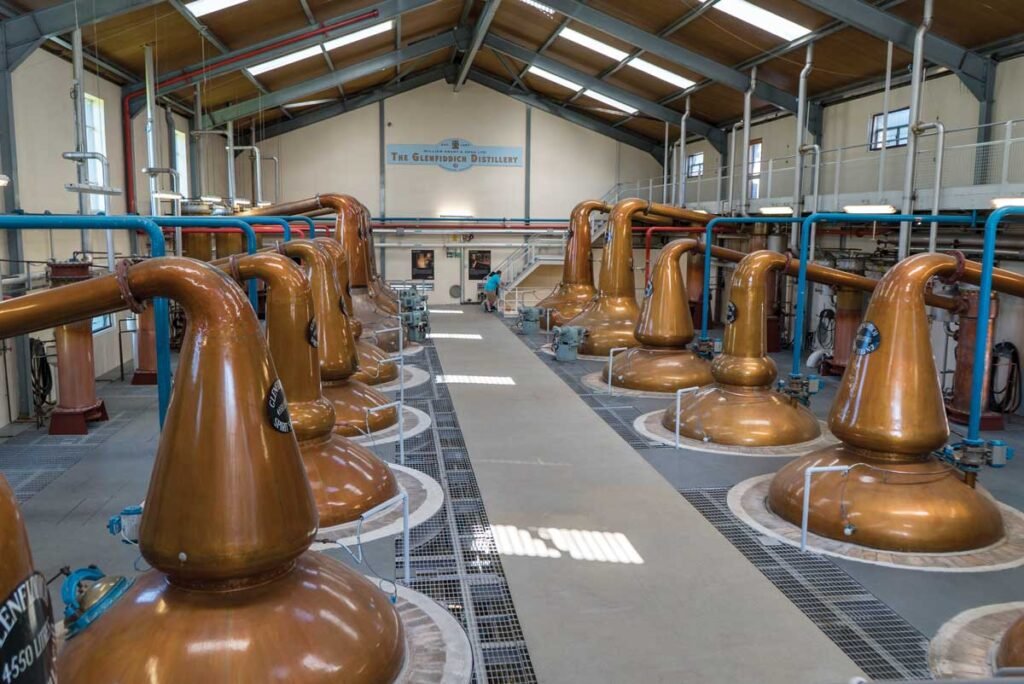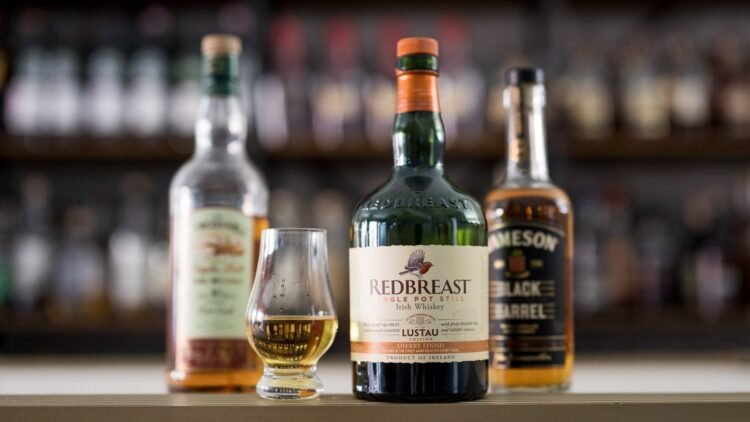Whiskey production is an intricate process that involves a delicate balance of ingredients, techniques, and time. One of the most crucial stages in whiskey-making is distillation, where the fermented mash is converted into high-proof alcohol. The type of distillation technique used—whether pot still or column still—can have a profound impact on the flavor, texture, and overall character of the final whiskey. In this article, we will explore the differences between pot still and column still distillation, how they influence whiskey flavor, and the role of distillation cuts in shaping the aroma and taste of whiskey.
The Basics of Distillation
Distillation is the process through which alcohol is separated from the fermented mash. It takes advantage of the differing boiling points of water and alcohol to separate the two. In the first stage of distillation, the wash (fermented mash) is heated in a still. The alcohol vaporizes at a lower temperature than the water, and the vapor is then condensed back into liquid form. This process increases the alcohol content of the liquid, concentrating the alcohol and other volatile compounds that contribute to flavor.
There are various types of stills used in distillation, but the two primary methods that have a significant impact on whiskey production are pot stills and column stills. The choice of still influences not only the alcohol concentration but also the flavor profile and mouthfeel of the final spirit.
Pot Still Distillation: Traditional and Flavorful
Pot stills are the traditional distillation method used in many of the world’s most famous whiskey-producing regions, particularly in Scotland and Ireland. The pot still is a large, bulbous copper vessel with a long neck that gradually narrows to a smaller opening. The shape of the pot still and the slow, controlled distillation process are key to its influence on the whiskey’s flavor.
1. How Pot Still Distillation Works
In pot still distillation, the wash is placed into the pot still and heated to a boil. As the temperature increases, the alcohol begins to vaporize. The vapor rises up the neck of the still and passes through a condenser, where it cools and returns to liquid form. In a typical pot still, distillation occurs in two or more stages, where the wash is distilled twice (or sometimes more), producing a more refined and concentrated spirit.
The pot still method is typically slower and more labor-intensive than column still distillation. This slower pace allows for more control over the distillation process, which ultimately impacts the final flavor of the whiskey. Pot stills are often favored for their ability to preserve complex flavors, resulting in whiskeys that are rich, full-bodied, and nuanced.
2. Flavor Impact of Pot Still Distillation
Pot still distillation allows for the retention of a broader range of compounds, including esters, aldehydes, and congeners, all of which contribute to the flavor and aroma of the whiskey. These compounds add depth, complexity, and a distinctive character that is often described as “pot still character.”
The use of pot stills also allows for a higher concentration of heavier flavors. For example, pot still whiskies tend to have a fuller mouthfeel, with richer and more complex flavors such as fruits, spices, and malt. This is particularly true for whiskies made in Scotland (such as single malt Scotch) and Ireland (such as pot still Irish whiskey), where the method has been refined for centuries. The shape of the pot still itself—especially the long neck—helps remove volatile compounds, leaving behind a smoother, more refined product.
3. Examples of Pot Still Whiskies
Many traditional and iconic whiskies are distilled in pot stills. Some of the most well-known examples include Glenfiddich, Lagavulin, and Talisker from Scotland, as well as Redbreast and Midleton from Ireland. These whiskies are often characterized by rich and robust flavors with a balance of fruit, malt, and sometimes a touch of smoke or spice.
Column Still Distillation: Efficient and Lighter
Column stills, also known as continuous stills, are a more modern and efficient form of distillation. They are typically used in large-scale whiskey production due to their ability to produce large quantities of high-proof alcohol in a shorter amount of time. Column stills are tall, cylindrical columns that contain a series of trays or plates that allow for continuous vaporization and condensation.
1. How Column Still Distillation Works
Column still distillation works by continuously feeding the wash into the top of the column, where it is heated. The alcohol in the wash rises through the column, where it passes over a series of trays that allow for repeated condensation and vaporization. As the alcohol rises, the concentration of alcohol increases, and the vapor is eventually condensed into a high-proof liquid.
Unlike pot still distillation, which operates in batches, column stills continuously distill the wash without the need for stopping and starting. This process allows for higher efficiency, as it can produce large quantities of high-proof alcohol continuously. Column stills are also able to produce a much more refined, clean, and higher-proof distillate.
2. Flavor Impact of Column Still Distillation
Column still distillation is typically associated with lighter, cleaner spirits. Since the continuous distillation process strips away more impurities and congeners compared to pot still distillation, the resulting whiskey tends to have a smoother, more neutral flavor profile. While this can result in a high-quality product, it lacks the rich, complex flavors found in pot still-distilled whiskeys.
Whiskeys made using column stills are often described as having a more delicate, less intense flavor. They tend to be more straightforward, with a focus on grain and sweetness, and can sometimes lack the depth and character associated with pot still whiskies. The higher purity of the alcohol results in a smoother mouthfeel but may also miss some of the heavier, more distinctive flavors present in pot still whiskies.
Column stills are particularly favored in the production of American whiskey (like bourbon) and Canadian whisky, as well as in some blended Scotch whiskies where smoothness and consistency are prioritized.
3. Examples of Column Still Whiskies
Some of the most famous whiskies produced using column stills include Jim Beam, Jack Daniel’s, and Canadian Club. These brands produce whiskies that are known for their smooth, approachable character and are often used in cocktails or consumed as easy-drinking spirits.

The Influence of Distillation Cuts on Flavor and Aroma
In both pot still and column still distillation, there are key moments during the distillation process known as the “cuts.” These cuts divide the distillation process into three parts: the “heads,” the “hearts,” and the “tails.”
1. Heads: The First Cut
The heads are the initial portion of the distillation run. These are the most volatile compounds in the distillate and are often discarded because they can contain harmful substances like methanol. The heads typically have a sharp, pungent, and often unpleasant smell, and they are not used in the final whiskey product. However, in some cases, very small amounts of heads may be blended into the final product for a unique flavor characteristic.
2. Hearts: The Best Part of the Run
The hearts are the central portion of the distillation run, and this is the part that is retained and used to make whiskey. The hearts contain the highest concentration of ethanol, along with desirable flavor compounds that contribute to the whiskey’s aroma and taste. The quality and composition of the hearts directly impact the final whiskey, so the distiller’s skill in identifying the precise moment to make the cut is crucial.
The hearts typically contain a harmonious balance of the spirit’s essential flavors, such as sweetness, spice, fruit, and malt, depending on the type of whiskey being produced. In pot still distillation, the hearts can be particularly rich and complex, while in column still distillation, the hearts are often cleaner and lighter.
3. Tails: The Last Cut
The tails are the final portion of the distillation run. They contain heavier compounds like fusel oils and are generally discarded or redistilled for future use. The tails often have a muddy or oily character and can contribute unpleasant flavors. Some distilleries may collect the tails and combine them with the hearts for future distillation runs, but they are typically not included in the final product.
4. The Influence of Cuts on Flavor
The way a distiller makes the cuts between heads, hearts, and tails has a direct impact on the flavor of the whiskey. A more refined, precise cut will result in a cleaner and more balanced whiskey, while a less careful cut may result in a spirit that is too harsh or unrefined. The timing of the cuts is often a matter of experience, and it is one of the factors that separates good distillers from great ones.
For example, in pot still distillation, the hearts may have a fuller range of flavors due to the presence of congeners, which contribute to the richness of the whiskey. In contrast, column still distillation typically results in a more neutral, clean cut, which leads to a smoother but less complex whiskey.
Conclusion
The distillation technique used in whiskey production plays a vital role in shaping the final flavor profile of the spirit. Pot still distillation, with its slower process and ability to retain a wide range of congeners, tends to produce rich, full-bodied whiskies with complex flavors. In contrast, column still distillation is faster and more efficient, resulting in lighter, cleaner whiskies that prioritize smoothness over complexity.
The distillation cuts—heads, hearts, and tails—are also crucial in determining the flavor and aroma of the whiskey. A skilled distiller’s ability to make precise cuts ensures that the final product is harmonious, well-balanced, and reflective of the distillation process.
Ultimately, the choice of distillation method, along with the skill of the distiller, determines the character of the whiskey and influences its appeal to different palates. Whether you prefer the bold, rich flavors of pot still whiskies or the smooth, approachable character of column still whiskies, understanding the distillation process adds an extra layer of appreciation to the craft of whiskey-making.































